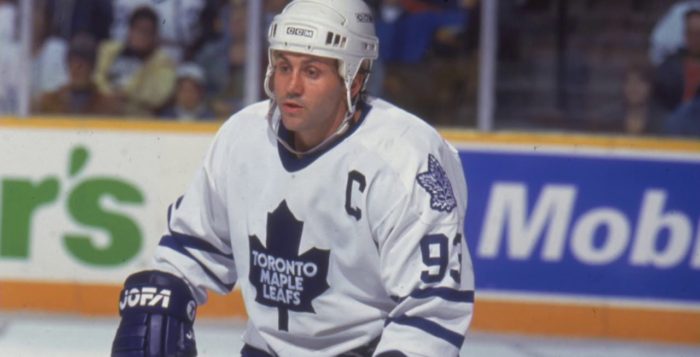This Day in Hockey History – August 18, 1994 – A Killer Captain
Doug “Killer” Gilmour, a small but tough two-way center, came to the Toronto Maple Leafs at the very start of 1992 and became their captain on August 18, 1994. He later wrote, “I was so proud to wear the C on the blue and white sweater.”
Upon being drafted late (due to his size), in the 1982 Entry Draft, Gilmour began his NHL career with the St. Louis Blues. After five years, he was traded (in the midst of a legal battle) to the Calgary Flames, and that first season, 1988-89, he helped them win the Stanley Cup. During the 1990-91 season, he (and two others) rotated the captaincy. Due to a bitter salary dispute requiring arbitration, Gilmour requested a trade. On New Year’s Eve 1991, he helped the Flames beat the Montreal Canadiens then walked out.
Gilmour started 1992 as part of the largest NHL trade, involving ten players swapped between Calgary and Toronto. He soon became a Leafs fan favorite, which was solidified after he set the franchise record by scoring 127 points during the 1992-93 season. That postseason, he set another scoring record with 35 points. Toronto seemed poised to win the Campbell Conference Final when Wayne Gretzky’s stick cut Gilmour’s chin enough to need eight stitches. Instead of penalizing Gretzky, he scored the game-winning goal within seconds and led the Los Angeles Kings to victory in Game 7. Despite that disappointment, Gilmour won the Frank J. Selke Trophy as the top defensive forward.
Over the next season, Gilmour sometimes filled in as captain when Wendel Clark was out with injuries. Toronto was shocked when, on June 28, 1994, Captain Clark was traded to the Quebec Nordiques for Mats Sundin. Gilmour became the natural choice to replace him. Having twice taken him in from other teams, GM Cliff Fletcher commented, “Doug and I go back a ways before Toronto. In Calgary I had good teams, but never good enough to win it all. Then, in 1988, we got Doug (from St. Louis) and we won the Stanley Cup his first year. And when I got Gilmour for Toronto in mid ’92, it immediately made me a better general manager. We were 15 games under .500 when he arrived and we’ve never been under since.” Gilmour himself had a few reservations. “You can never replace a guy like Wendel Clark. There was a little discomfort initially. I’m glad the organization waited to make the announcement.”
Still, the Maple Leafs chose Gilmour as Toronto’s 15th captain. He wanted a low-key announcement, but the event took place at the Hockey Hall of Fame, where Gilmour would be inducted in 2011. The franchise brought in no less than six former captains to welcome him. Darryl Sittler (captain from 1975-81) remarked, “You are not named captain of a team unless you have some leadership qualities. Obviously, Doug has leadership qualities. I didn’t change just because I was named captain. The thing you have to do is include other players with the leadership qualities. Wendel did that with Doug.” Gilmour did not plan to change his tight-lipped style once captain. “I might have to open my mouth a bit more in public. But I’m not going to change. I’m not a rah-rah guy. But Wendel wasn’t vocal either. He picked his spots to say things. I’m the same way.” Coach Pat Burns had no problem with that saying, “Of course, Dougie was the logical choice. Rah-Rah captains don’t exist any more. Go out and lead by example types are now important.”
Before Gilmour could officially serve as captain, the 1994-95 season was delayed by a lockout. He played in Switzerland until he could return to the Maple Leafs. Gilmour remained captain for nearly three seasons before being traded to the New Jersey Devils on February 25, 1997. During the summer of 1998, he signed with the Chicago Blackhawks, who traded him to the Buffalo Sabres in March 2000. In October 2001, Gilmour signed with the Montreal Canadiens, who returned him to the Toronto Maple Leafs at the 2003 trade deadline. Unfortunately, Gilmour only had one last hurrah for his NHL playing career. In his only game back with Toronto, he tore his ACL and sat the remainder of the season. Toronto decided not to re-sign Gilmour, so he retired on September 8, 2003. Overall, Gilmour spent 20 years in the NHL, playing 1,474 games with 1,414 points.
After his playing career ended, from 2006-2008, Gilmour became a player development advisor for the Leafs. Then for a few months, he served as assistant coach for their AHL affiliate, the Toronto Marlies. Gilmour then became the head coach for the OHL’s Kingston Frontenacs, where he became GM in 2011. That was the year the Ontario Sports Hall of Fame inducted him. The Maple Leafs raised his No. 93 to the rafters in 2009 and officially retired it in 2016.
Additional Sources:
- Mike Commito, Hockey 365: Daily Stories from the Ice(Toronto: Dundurn, 2018), kindle edition.
- https://www.hockey-reference.com/players/g/gilmodo01.html
- https://www.hhof.com/htmlInduct/ind11Gilmour.shtml
- Tim Wharnsby, “The Killer will lead the Leafs by example,” Toronto National Post, 19 Aug. 1994, p. 43.
- “Gilmour gets captain’s job,” Calgary Herald, 19 Aug. 1994, p. C2.
- https://thepinkpuck.com/2019/06/17/this-day-in-hockey-history-june-17-1989-swede-sundin-selected/














